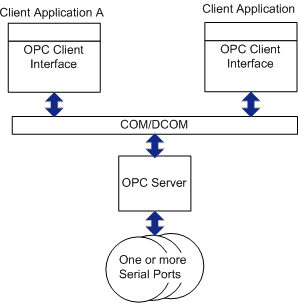The following diagram illustrates the client / server architecture defined by the OPC specification.

![]() Multiple OPC compliant client
applications can communicate with an OPC server simultaneously.
Multiple OPC compliant client
applications can communicate with an OPC server simultaneously.
![]() DCOM, client and server software
programs can be configured to run on the same computer node or be
distributed across a network of computers.
DCOM, client and server software
programs can be configured to run on the same computer node or be
distributed across a network of computers.
![]() OPC servers provide a common view
of automation information managed by the system for which the
server was written.
OPC servers provide a common view
of automation information managed by the system for which the
server was written.
![]() The GagePort Mitutoyo OPC Server
allows an OPC client to read gage values from Mitutoyo gage
hubs.
The GagePort Mitutoyo OPC Server
allows an OPC client to read gage values from Mitutoyo gage
hubs.
Other examples include an OPC server for a PLC providing access to PLC registers or an OPC server for a lab analyzer providing remote monitoring (and control).
![]() OPC clients use this common view
of automation information in a variety of ways.
OPC clients use this common view
of automation information in a variety of ways.
This includes providing:
![]() Human machine interfaces.
Human machine interfaces.
![]() Historical data logging.
Historical data logging.
![]() Data mirroring services.
Data mirroring services.
Users can write their own custom programs in languages such as Visual Basic or Visual C++.
Desktop programs can reference OPC server information. For example, users can write VBA scripts in Microsoft Excel.
|
About OPC servers. |